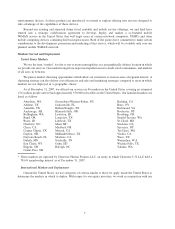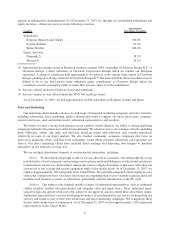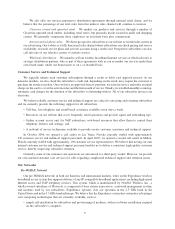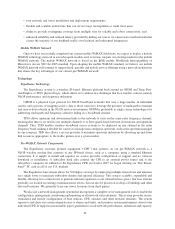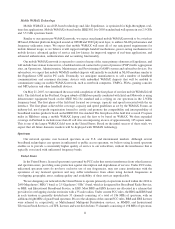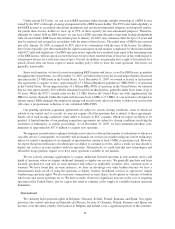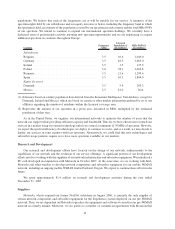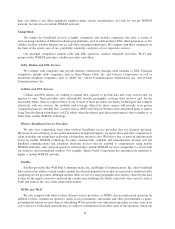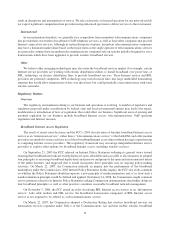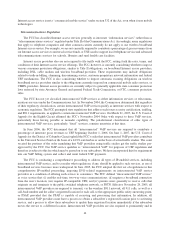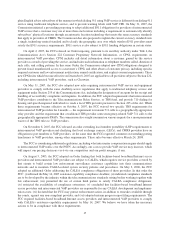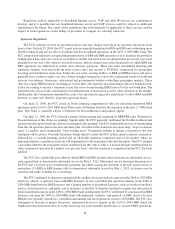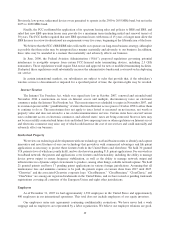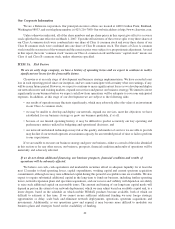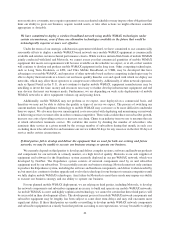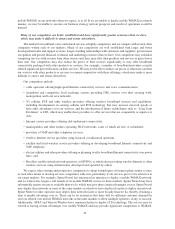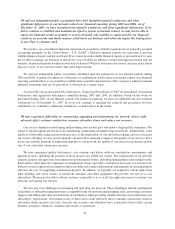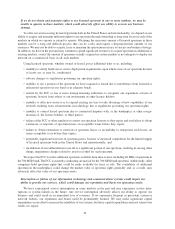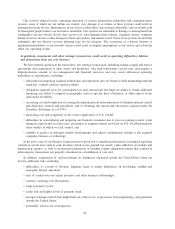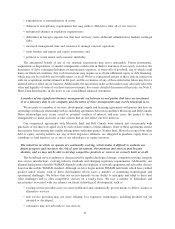Clearwire 2007 Annual Report Download - page 25
Download and view the complete annual report
Please find page 25 of the 2007 Clearwire annual report below. You can navigate through the pages in the report by either clicking on the pages listed below, or by using the keyword search tool below to find specific information within the annual report.plain English advise subscribers of the manner in which dialing 911 using VoIP service is different from dialing 911
service using traditional telephone service, and to provide warning labels with VoIP CPE. On May 31, 2007, the
Commission initiated a proceeding proposing to adopt additional E911 obligations for providers of interconnected
VoIP service that a customer may use at more than one location including a requirement to automatically identify
subscribers’ physical locations through an automatic location technology that meets the same accuracy standards
that apply to providers of CMRS. The Commission has also proposed to tighten the current accuracy standards into
a single, technology neutral standard and to clarify the geographic area over which wireless E911 providers must
satisfy the E911 accuracy requirements. E911 service is also subject to E911 funding obligations in certain states.
On April 2, 2007, the FCC released an Order imposing, pursuant to its ancillary authority under Title I, the
Communications Act’s Section 222 Customer Proprietary Network Information, or CPNI, requirements on
interconnected VoIP providers. CPNI includes call detail information about a customer gained by the service
provider as a result of providing the service, and includes such information as telephone numbers called, duration of
such calls, and calling patterns. In this same Order, the Commission adopted new CPNI obligations designed to
prevent fraud, unauthorized access to a customer’s CPNI, and other abuses of customer privacy, including specific
required customer and law enforcement notification, annual certification, and explicit consent requirements. These
new CPNI rules which become effective on December 8, 2007 are applicable to all providers subject to Section 222,
including interconnected VoIP providers, such as Clearwire.
On May 31, 2007, the FCC also adopted new rules requiring interconnected VoIP service and equipment
providers to comply with the same disability-access regulations that apply to traditional telephony service and
equipment under Section 255 of the Communications Act, including the designation of an agent for the receipt and
handling of accessibility complaints and inquiries. In addition, the FCC adopted requirements that interconnected
VoIP providers contribute to the Telecommunications Relay Service, or TRS fund, and provide 711-dialing for
hearing and speech-impaired individuals to reach a local TRS provider pursuant to Section 225 of the Act. While
these requirements became effective on October 5, 2007, the FCC waived two specific TRS requirements for
interconnected VoIP providers for 6 months — the requirement to transmit 711 calls to a geographically appropriate
relay provider and the requirement that a traditional TRS provider route emergency-related VoIP 711 calls to the
geographically appropriate PSAPs. The commission also sought comment on various requests for a more permanent
waiver of the TRS rules to VoIP providers.
On November 8, 2007, the FCC released an order extending local number portability (LNP) requirements to
interconnected VoIP providers and clarifying that local exchange carriers, (LECs), and CMRS providers have an
obligation to port numbers to VoIP providers. At the same time the FCC requested comment on extending porting
timeframes to VoIP providers, among other requirements. These rules become effective March 24, 2008.
The FCC is considering additional regulations, including what intercarrier compensation regime should apply
to interconnected VoIP traffic over the PSTN. Accordingly, our costs to provide VoIP service may increase, which
will impact our pricing decisions vis-à-vis our competitors and our profit margins, if any.
On August 5, 2005, the FCC adopted an Order finding that both facilities-based broadband Internet access
providers and interconnected VoIP providers are subject to CALEA, which requires service providers covered by
that statute to build certain law enforcement surveillance assistance capabilities into their communications
networks and to maintain CALEA-related system security policies and procedures. On May 3, 2006, the FCC
adopted an additional Order addressing the CALEA compliance obligations of these providers. In that order the
FCC: (i) affirmed the May 14, 2007 assistance-capability compliance deadline; (ii) indicated compliance standards
are to be developed by the industry within the telecommunications standards setting bodies working together with
law enforcement; (iii) permitted the use of certain third parties to satisfy CALEA compliance obligations;
(iv) restricted the availability of compliance extensions; (v) concluded that facilities-based broadband Internet
access providers and interconnected VoIP providers are responsible for any CALEA development and implemen-
tation costs; (vi) declared that the FCC may pursue enforcement action, in addition to remedies available through
the courts, against any non-compliant provider; and (vii) adopted interim progress report filing requirements. The
FCC required facilities-based broadband Internet access providers and interconnected VoIP providers to comply
with CALEA’s assistance-capability requirements by May 14, 2007. We believe we have taken the necessary
actions to be in compliance with these requirements.
17


